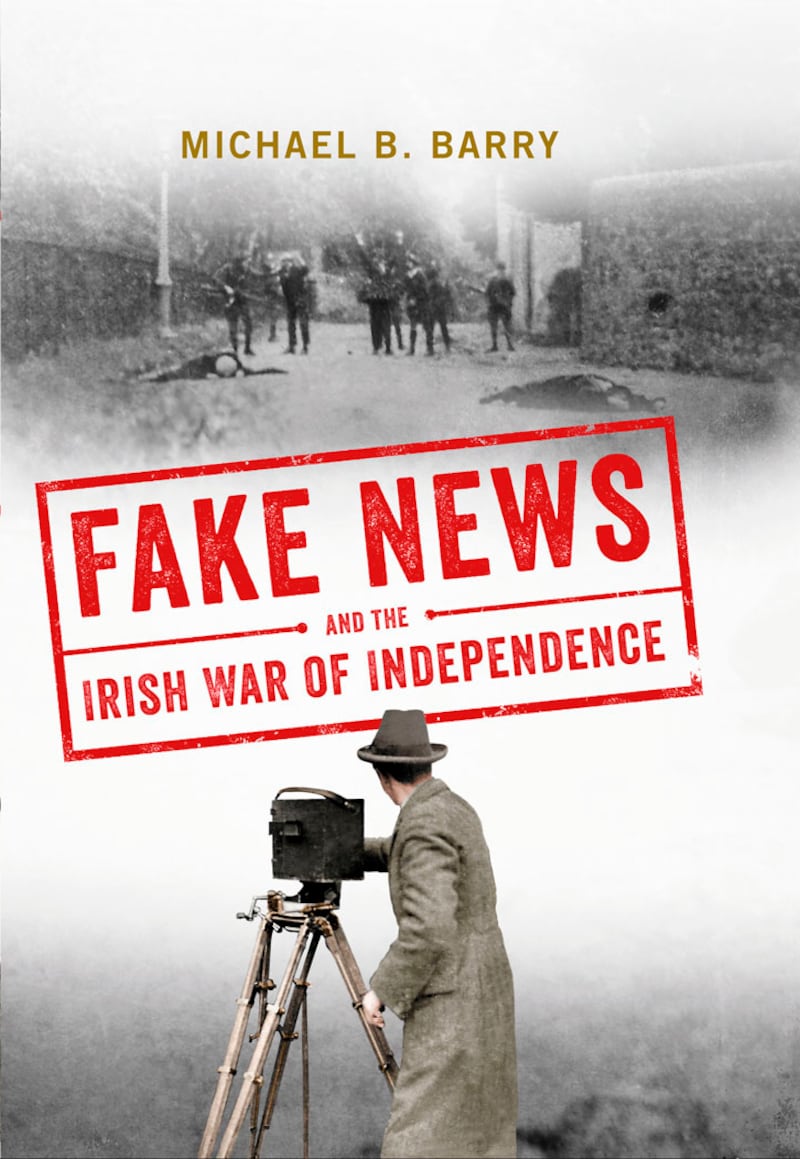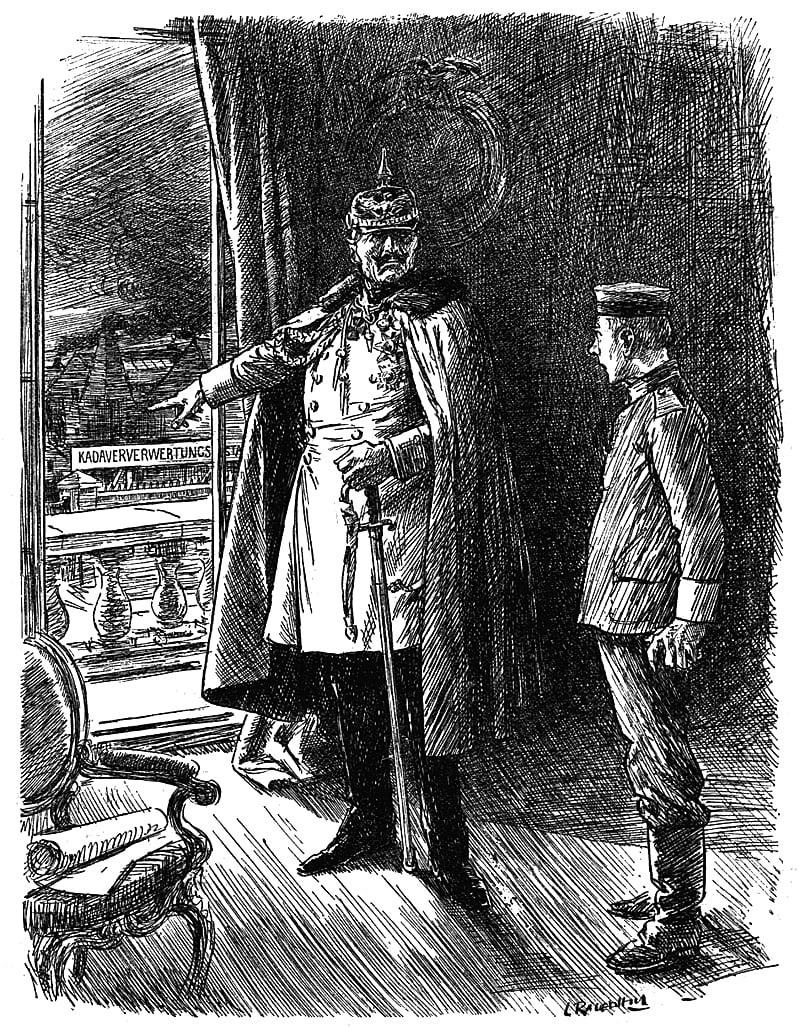An ambush on January 1919 by volunteers at Soloheadbeg, coincidentally on the same day as the First Dáil, is generally considered as marking the start of the War of Independence. The struggle soon became increasingly ruthless. Across the country, the effectiveness of the RIC diminished as they were attacked. With police ranks depleted, ex-servicemen were recruited, who gained the soubriquet of Black and Tans. As IRA actions escalated, a paramilitary force of ex-officers, the Auxiliary Division, was introduced in mid-1920.
Sinn Féin was very aware of the need to publicise their cause and established a Department of Propaganda, which from June 1919 was directed by the poet and writer Desmond FitzGerald. With a feel for propaganda, FitzGerald travelled on several occasions to London where he established contacts with foreign journalists and editors of news agencies. In the meantime, Sinn Féin envoys in international capitals spread the message, producing pamphlets and posters in the local language.

As fatalities and reprisals increased during 1920, interest in Ireland grew and many British, American and continental journalists arrived in Dublin to see for themselves. In November 1919 Sinn Féin began publication of the Irish Bulletin, which was soon issued five times a week. Within its pages it reported on the activities of the IRA and catalogued the actions of the Crown Forces. As reprisals increased, reports of these took up increasing space in the paper. In general, the Irish Bulletin maintained a measured tone and avoided fabrications. It had developed a circulation list which included politicians and press in Britain as well as international journalists. Its reputation for accuracy was such that recipients first turned to it for information rather than to the blatantly false press notices that emanated from Dublin Castle.
As part of a major shake-up of the administration in Dublin that commenced in April 1920, the British appointed pressmen to present the official view on the events of the conflict. Principal amongst these was an experienced newsman, Basil Clarke, who took up the position of head of the Public Information Bureau in Dublin Castle. He endeavoured to apply his “propaganda by information” formula, by presenting news that was supposedly only adjusted in minor ways. He did achieve some success, and was unchallenged in some areas, such as the proposition that the IRA had mutilated the Auxiliary corpses with axes at the Kilmichael ambush. Clarke did his best, amidst a discordant grouping of the press offices of the civilian administration, the police and the military.
It is worth noting here that the British had been masters of propaganda during the first Word War. From September 1914, their War Propaganda Bureau produced a stream of books, pamphlets and articles, mainly directed at neutral countries, with the United States the principal target. Surreptitious subsidies were paid to newspapers around the world, and the ostensibly respectable Reuters news agency was contracted under a secret agreement to disseminate British propaganda around the world. By contrast the German propaganda effort was cack-handed and a perception of brutish behaviour by the Germans prevailed worldwide. That expert in malevolent propaganda, Adolf Hitler, in Mein Kampf noted that the British campaign had been “an inspired work of genius” and was “a weapon of the first order”.
As I found out when researching my book on Fake News and the Irish War of Independence, there was little evidence of inspired genius on display in Dublin Castle in 1920. In the febrile atmosphere prevailing there, the free spirits in the police press office came up with an increasing number of fantastical and unbelievable examples of fake news.

One of these free spirits was Captain Hugh Bertie Pollard, who had worked in MI7.b, the secretive propaganda department of military intelligence during the first World War. He had been the instigator of the most successful propaganda hoax of the war – the story that the Germans had created a Corpse Factory to turn their dead into lubricating oil. Pollard had been assigned to the Information Section of the Police Authority in Dublin Castle. From August 1920 Pollard and his colleague, Captain William Darling, produced the Weekly Summary, flawed and full of blatant propaganda. This made the Sinn Féin Irish Bulletin look good by comparison – in April 1921 it was paid the ultimate compliment when, after seizure of the equipment, Pollard and Darling produced fake versions.
The staging of the so-called Battle of Tralee was probably the most egregious example of fake news during the War of Independence. Pollard was accompanying a press party which was touring the south of the country. On the afternoon of November 12th 1921 they came upon the aftermath of a skirmish with the IRA at Ballymacelligott near Tralee. Some days later in the British press photographs of the Battle of Tralee appeared showing bodies lying around and with Auxiliaries rounding up “Sinn Féiners”.
On November 27th, the Irish Independent revealed that the photos had been taken at Vico Road, Killiney, Co Dublin. The caption drily noted that the “Battle of Tralee ended for the convenience of the photographer in Co. Dublin”. There was commotion in the House of Commons, to the embarrassment of the government, as nationalist MPs exposed the fraud. Thus, thanks to Captain Pollard and his colleagues, the British propaganda system in Dublin Castle, already fragmented and lacking direction, was frequently unbelievable. However, one of the fundamental problems was the message, as acknowledged by Basil Clarke when he self-servingly later wrote in a memo, “the fault is not that of the propaganda, but of the subject of propaganda. It is a bad case, and no propaganda will win a public sanction for it.”
During the initial stages of the War of Independence, much of the press in Britain reported the official version that it was a police war against the criminal conspiracy of the “Sinn Féin murder gang”. This was also passed on by the multitude of press agencies based in London and circulated around the world.
Some of the British press, like the Morning Post, could be relied on to mindlessly repeat official propaganda throughout the conflict. Others, like the Manchester Guardian and the Daily News, took an independent view and became increasingly critical of government policy on Ireland. Many presented the IRA violence as wrong but came to see it as the consequence of misgovernment and repression.
Reprisals, such as the burning of Ireland’s towns by Crown forces, increased in intensity in the second half of 1920, news of which came to be reported widely in the British and international press. The sack of Balbriggan on September 20th, 1920 gained particular notoriety, not just due to the extensive destruction, but also because it was near Dublin, thus easier for journalists to visit. Scores of houses were burned and much of the population had to abandon the town – the shocking news flashed around the world. The Daily Mail wrote after Balbriggan: “half the world is coming to feel that our Government is condoning vendetta and turning a blind eye upon the execution of lawless reprisals… the slur on our nation’s good name becomes insufferable.”
Thus, as the War of Independence increased in intensity, with the underlying story of atrocities by Crown forces being so blatant, a general impression of British brutality seeped through. This narrative reached the United States, the most important and influential country as far as the British were concerned. That begetter of the Auxiliaries, Winston Churchill, secretary of state for the colonies, advised his cabinet colleagues in May 1921 that it was time for a respite in Ireland, as the news from there was damaging “the interests of this country all over the world; we are getting an odious reputation, poisoning our relations with the United States”.
By mid-1921, the British cabinet was vacillating between a drive to intensify the war and the urge to negotiate a truce. As the cabinet well knew, any increased military action was difficult in the glare of publicity. On June 24th, 1921 Lloyd George called for talks. In response, de Valera called a conference for July 4th in Dublin to discuss Lloyd George’s proposal. Prime minister Craig refused to come. De Valera, “spokesman of the nation”, as he described himself, met the southern Unionists at the Mansion House in Dublin. General Macready met de Valera on July 8th and terms for a truce were agreed. In the months that followed, negotiations led to the Anglo-Irish Treaty of December 1921.

In conclusion, even though the British had established a powerful propaganda system and network during the first World War, their performance during the War of Independence was woeful, with much confusion and, as we have seen, propaganda that verged on the slapstick. By contrast, Sinn Féin was more successful with propaganda, simply by sticking to the truth. The news about British atrocities that began to percolate into the world's press offended the British self-image that their empire stood for fairness and justice. It was the pressure of this continuous opprobrium as well as the military campaign of the IRA that forced the British to the negotiating table.
Historian Michael B Barry's new book, Fake News and the Irish War of Independence (Andalus Press), has just been published.




















